Industrial Damper Manufacturer in India +91-9881236139
INDUSTRIAL DAMPER
A damper is a valve or plate that stops or regulates the flow of air inside a duct, chimney, VAV box, air handler, or other air-handling equipment. A damper may be used to cut off central air conditioning (heating or cooling) to an unused room, or to regulate it for room-by-room temperature and climate control. Its operation can be manual or automatic. Manual dampers are turned by a handle on the outside of a duct. Automatic dampers are used to regulate airflow constantly and are operated by electric or pneumatic motors, in turn controlled by a thermostat or building automation system. Automatic or motorized dampers may also be controlled by a solenoid, and the degree of air-flow calibrated, perhaps according to signals from the thermostat going to the actuator of the damper in order to modulate the flow of air-conditioned air in order to effect climate control.[1]In a chimney flue, a damper closes off the flue to keep the weather (and birds and other animals) out and warm or cool air in. This is usually done in the summer, but also sometimes in the winter between uses. In some cases, the damper may also be partly closed to help control the rate of combustion. The damper may be accessible only by reaching up into the fireplace by hand or with a wood poker, or sometimes by a lever or knob that sticks down or out. On a wood-burning stove or similar device, it is usually a handle on the vent duct as in an air conditioning system. Forgetting to open a damper before beginning a fire can cause serious smoke damage to the interior of a home, if not a house fire.
Read More
Automated zone dampers
An opposed-blade, motor-closed, motor-opened zone damper. The damper is shown in the "open" position.
Close-up
of the motor connections. This damper can switch the electrical power
to control additional "slave" dampers, minimizing the electrical load on
the damper's control circuitry and power transformer
Zone dampers as used in home HVAC systems are usually electrically powered. In large commercial installations, vacuum or compressed air may be used instead. In either case, the motor is usually connected to the damper via a mechanical coupling.
For electrical zone dampers, there are two principal designs.
In one design, the motor is often a small shaded-pole synchronous motor combined with a rotary switch that can disconnect the motor at either of the two stopping points ("damper open" or "damper closed"). In this way, applying power to the "open damper" terminal causes the motor to run until the damper is open while applying power at the "close damper" terminal causes the motor to run until the damper is closed. The motor is commonly powered from the same 24 volt AC power source that is used for the rest of the control system. This allows the zone dampers to be directly controlled by low-voltage thermostats and wired with low-voltage wiring. Because simultaneous closure of all dampers might harm the furnace or air handler, this style of damper is often designed to only obstruct a portion of the air duct, for example, 75%.
Another style of electrically powered damper uses a spring-return mechanism and a shaded-pole synchronous motor. In this case, the damper is normally opened by the force of the spring but can be closed by the force of the motor. Removal of electrical power re-opens the damper. This style of damper is advantageous because it is "fail safe"; if the control to the damper fails, the damper opens and allows air to flow. However, in most applications "fail safe" indicates the damper will close upon loss of power thus preventing the spread of smoke and fire to other areas. These dampers also may allow adjustment of the "closed" position so that they only obstruct, for example, 75% of the air flow when closed.
For vacuum-operated or pneumatically operated zone dampers, the thermostat usually switches the pressure or vacuum on or off, causing a spring-loaded rubber diaphragm to move and actuate the damper. As with the second style of electrical zone dampers, these dampers automatically return to the default position without the application of any power, and the default position is usually "open", allowing air to flow. Like the second style of electrical zone damper, these dampers may allow adjustment of the "closed" position.
Highly sophisticated systems may use some form of building automation such as BACnet or LonWorks to control the zone dampers. The dampers may also support positions other than fully open or fully closed and are usually capable of reporting their current position and, often, the temperature and volume of the air flowing past the smart damper.
Regardless of the style of damper employed, the systems are often designed so that when no thermostat is calling for air, all dampers in the system are opened. This allows air to continue to flow while the heat exchanger in a furnace cools down after a heating period completes.
Comparison to multiple furnaces/air handlers
Multiple zones can be implemented using either multiple, individually controlled furnaces/air handlers or a single furnace/air handler and multiple zone dampers. Each approach has advantages and disadvantages.Multiple furnaces/air handlers
Advantages:- Simple mechanical and control design ("SPST thermostats")
- Redundancy: If one zone furnace fails, the others can remain working
- Cost. Furnaces cost much more than zone dampers
- Power consumption. Operating furnaces draw power whereas a zone damper only draws power while in motion from one state to the other (or, in some cases, a very small amount of power while holding closed)
Zone dampers
Advantages:- Cost.
- Power consumption.
- New US residential building codes require permanent access to dampers through ceiling access panels.
- Zone dampers are not 100% reliable. Most styles of motor-to-open/motor-to-closed electrically operated zone dampers aren't "fail safe" (that is, they do not fail to the open condition). However, zone dampers that are of the "Normally Open" type are fail-safe, in that they will fail to the open condition.
- No inherent redundancy for the furnace. A system with zone dampers is dependent upon a single furnace. If it fails, the system becomes completely inoperable.
- Low total flow when only some dampers are open can cause inefficient operation.
- Supply and return ducts need dampers to avoid pressurization of portions of the building.
- The system can be harder to a design, requiring both "SPDT" thermostats (or relays) and the ability of the system to withstand the fault condition whereby all zone dampers are closed simultaneously.
Fire dampers
Fire dampers are fitted where ductwork passes through fire compartment walls / fire curtains as part of a fire control strategy. In normal circumstances, these dampers are held open by means of fusible links. When subjected to heat, these links fracture and allow the damper to close under the influence of the integral closing spring. The links are attached to the damper such that the dampers can be released manually for testing purposes. The damper is provided with an access door in the adjacent ductworks for the purpose of inspection and resetting in the event of closure.Variable air volume
Variable air volume (VAV) is a type of heating, ventilating, and/or air-conditioning (HVAC) system. Unlike constant air volume (CAV) systems, which supply a constant airflow at a variable temperature, VAV systems vary the airflow at a constant temperature. The advantages of VAV systems over constant-volume systems include more precise temperature control, reduced compressor wear, lower energy consumption by system fans, less fan noise, and additional passive dehumidification
Simple VAV systems
The simplest VAV system incorporates one supply duct that, when in cooling mode, distributes supply air at a constant temperature of approximately 55 °F (13 °C). Because the supply air temperature is constant, the air flow rate must vary to meet the rising and falling heat gains or losses within the thermal zone served.Even a simple VAV system has several advantages over a CAV system. One is more precise temperature control. To meet a space cooling load, a CAV unit operates the fan and compressor at full capacity until the temperature drops to a specified limit, and then the compressor turns off. This on/off cycling causes the temperature to fluctuate above and below the temperature setpoint. In a single-zone VAV unit, the fan speed varies depending on the actual space temperature and the temperature setpoint, while the compressor modulates the refrigerant flow to maintain a constant supply air temperature. The result is more precise space temperature control.
Another advantage is energy savings and reduced wear. VAV fan control, especially with modern electronic variable-speed drives, reduces the energy consumed by fans, which can be a substantial part of the total cooling energy requirements of a building. Modulating control of the compressor also reduces wear and delivers further energy savings.
A final advantage is increased dehumidification. Because VAV air flow is reduced under part-load conditions, air is exposed to cooling coils for a longer time. More moisture condenses on the coils, dehumidifying the air. Thus, although a constant-volume and a single-zone VAV unit maintain the same room temperature, the VAV unit provides more passive dehumidification and more comfortable space conditions.
Multiple-zone VAV systems
The air blower's flow rate is variable. For a single VAV air handler that serves multiple thermal zones, the flow rate to each zone must be varied as well.
Simple VAV terminal unit
A common commercial application is shown in the diagram. This VAV system consists of a VAV box, ductwork, and four air terminals.
Fan control
Control of the system's fan capacity is critical in VAV systems. Without proper and rapid flow rate control, the system's ductwork, or its sealing, can easily be damaged by overpressurization. In the cooling mode of operation, as the temperature in the space is satisfied, a VAV box closes to limit the flow of cool air into the space. As the temperature increases in the space, the box opens to bring the temperature back down. The fan maintains a constant static pressure in the discharge duct regardless of the position of the VAV box. Therefore, as the boxes closes, the fan slows down or restricts the amount of air going into the supply duct. As the boxes open, the fan speeds up and allows more air flow into the duct, maintaining a constant static pressure.One of the challenges for VAV systems is providing adequate temperature control for multiple zones with different environmental conditions, such as an office on the glass perimeter of a building vs. an interior office down the hall. Dual duct systems provide cool air in one duct and warm air in a second duct to provide an appropriate temperature of mixed supply air for any zone. An extra duct, however, is cumbersome and expensive. Reheating the air from a single duct, using electric or hot water heating, is often a more cost-effective solution.
VIBRATION DAMPER
| Part of a series of articles about |
| Classical mechanics |
|---|
Second law of motion
|
|
Vibration can be desirable: for example, the motion of a tuning fork, the reed in a woodwind instrument or harmonica, a mobile phone, or the cone of a loudspeaker.
In many cases, however, vibration is undesirable, wasting energy and creating unwanted sound. For example, the vibrational motions of engines, electric motors, or any mechanical device in operation are typically unwanted. Such vibrations could be caused by imbalances in the rotating parts, uneven friction, or the meshing of gear teeth. Careful designs usually minimize unwanted vibrations.
The studies of sound and vibration are closely related. Sound, or pressure waves, are generated by vibrating structures (e.g. vocal cords); these pressure waves can also induce the vibration of structures (e.g. ear drum). Hence, attempts to reduce noise are often related to issues of vibration.

One of the possible modes of vibration of a circular drum (see other modes).

Car Suspension: designing vibration control is undertaken as part of acoustic, automotive or mechanical engineering.
Contents
- 1 Types of vibration
- 2 Vibration testing
- 3 Vibration analysis
- 3.1 Free vibration without damping
- 3.1.1 What causes the system to vibrate: from conservation of energy point of view
- 3.2 Free vibration with damping
- 3.2.1 Damped and undamped natural frequencies
- 3.3 Forced vibration with damping
- 3.3.1 Resonance causes
- 3.3.2 Applying "complex" forces to the mass–spring–damper model
- 3.3.3 Frequency response model
- 3.1 Free vibration without damping
- 4 Multiple degrees of freedom systems and mode shapes
- 4.1 Eigenvalue problem
- 4.2 Illustration of a multiple DOF problem
- 4.3 Multiple DOF problem converted to a single DOF problem
- 4.4 Rigid-body mode
- 5 See also
- 6 References
- 7 Further reading
- 8 External links
Types of vibration
Free vibration occurs when a mechanical system is set in motion with an initial input and allowed to vibrate freely. Examples of this type of vibration are pulling a child back on a swing and letting it go, or hitting a tuning fork and letting it ring. The mechanical system vibrates at one or more of its natural frequencies and damps down to motionlessness.Forced vibration is when a time-varying disturbance (load, displacement or velocity) is applied to a mechanical system. The disturbance can be a periodic and steady-state input, a transient input, or a random input. The periodic input can be a harmonic or a non-harmonic disturbance. Examples of these types of vibration include a washing machine shaking due to an imbalance, transportation vibration caused by an engine or uneven road, or the vibration of a building during an earthquake. For linear systems, the frequency of the steady-state vibration response resulting from the application of a periodic, harmonic input is equal to the frequency of the applied force or motion, with the response magnitude being dependent on the actual mechanical system.
Damped vibration: When the energy of a vibrating system is gradually dissipated by friction and other resistances, the vibrations are said to be damped. The vibrations gradually reduce or change in frequency or intensity or cease and the system rests in its equilibrium position. An example of this type of vibration is the vehicular suspension dampened by the shock absorber.
Vibration testing
Vibration testing is accomplished by introducing a forcing function into a structure, usually with some type of shaker. Alternately, a DUT (device under test) is attached to the "table" of a shaker. Vibration testing is performed to examine the response of a device under test (DUT) to a defined vibration environment. The measured response may be fatigue life, resonant frequencies or squeak and rattle sound output (NVH). Squeak and rattle testing is performed with a special type of quiet shaker that produces very low sound levels while under operation.For relatively low frequency forcing, servohydraulic (electrohydraulic) shakers are used. For higher frequencies, electrodynamic shakers are used. Generally, one or more "input" or "control" points located on the DUT-side of a fixture is kept at a specified acceleration.[1] Other "response" points experience maximum vibration level (resonance) or minimum vibration level (anti-resonance). It is often desirable to achieve anti-resonance to keep a system from becoming too noisy, or to reduce strain on certain parts due to vibration modes caused by specific vibration frequencies .[2]
The most common types of vibration testing services conducted by vibration test labs are Sinusoidal and Random. Sine (one-frequency-at-a-time) tests are performed to survey the structural response of the device under test (DUT). A random (all frequencies at once) test is generally considered to more closely replicate a real world environment, such as road inputs to a moving automobile.
Most vibration testing is conducted in a 'single DUT axis' at a time, even though most real-world vibration occurs in various axes simultaneously. MIL-STD-810G, released in late 2008, Test Method 527, calls for multiple exciter testing. The vibration test fixture used to attach the DUT to the shaker table must be designed for the frequency range of the vibration test spectrum. Generally for smaller fixtures and lower frequency ranges, the designer targets a fixture design that is free of resonances in the test frequency range. This becomes more difficult as the DUT gets larger and as the test frequency increases. In these cases multi-point control strategies can mitigate some of the resonances that may be present in the future. Devices specifically designed to trace or record vibrations are called vibroscopes.
Vibration analysis
This section does not cite any sources. (July 2013) (Learn how and when to remove this template message)
|
VA can use the units of Displacement, Velocity and Acceleration displayed as a time waveform (TWF), but most commonly the spectrum is used, derived from a fast Fourier transform of the TWF. The vibration spectrum provides important frequency information that can pinpoint the faulty component.
The fundamentals of vibration analysis can be understood by studying the simple Mass-spring-damper model. Indeed, even a complex structure such as an automobile body can be modeled as a "summation" of simple mass–spring–damper models. The mass–spring–damper model is an example of a simple harmonic oscillator. The mathematics used to describe its behavior is identical to other simple harmonic oscillators such as the RLC circuit.
Note: This article does not include the step-by-step mathematical derivations, but focuses on major vibration analysis equations and concepts. Please refer to the references at the end of the article for detailed derivations.
Free vibration without damping


Simple harmonic motion of the mass–spring system
What causes the system to vibrate: from conservation of energy point of view
Vibrational motion could be understood in terms of conservation of energy. In the above example the spring has been extended by a value of x and therefore some potential energy () is stored in the spring. Once released, the spring tends to return to its un-stretched state (which is the minimum potential energy state) and in the process accelerates the mass. At the point where the spring has reached its un-stretched state all the potential energy that we supplied by stretching it has been transformed into kinetic energy (). The mass then begins to decelerate because it is now compressing the spring and in the process transferring the kinetic energy back to its potential. Thus oscillation of the spring amounts to the transferring back and forth of the kinetic energy into potential energy. In this simple model the mass continues to oscillate forever at the same magnitude—but in a real system, damping always dissipates the energy, eventually bringing the spring to rest.Free vibration with damping

Mass–spring–damper model

Free vibration with 0.1 and 0.3 damping ratio
Damped and undamped natural frequencies
The major points to note from the solution are the exponential term and the cosine function. The exponential term defines how quickly the system “damps” down – the larger the damping ratio, the quicker it damps to zero. The cosine function is the oscillating portion of the solution, but the frequency of the oscillations is different from the undamped case.The frequency in this case is called the "damped natural frequency", and is related to the undamped natural frequency by the following formula:
The plots to the side present how 0.1 and 0.3 damping ratios effect how the system “rings” down over time. What is often done in practice is to experimentally measure the free vibration after an impact (for example by a hammer) and then determine the natural frequency of the system by measuring the rate of oscillation, as well as the damping ratio by measuring the rate of decay. The natural frequency and damping ratio are not only important in free vibration, but also characterize how a system behaves under forced vibration.
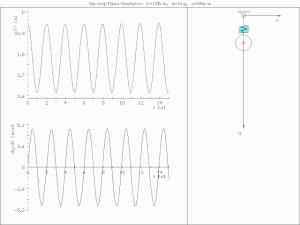
Spring mass undamped
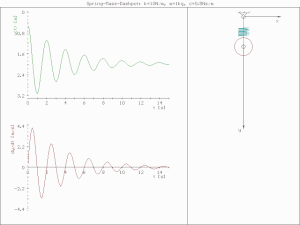
Spring mass underdamped
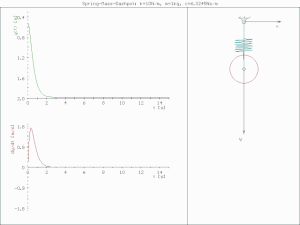
Spring mass critically damped
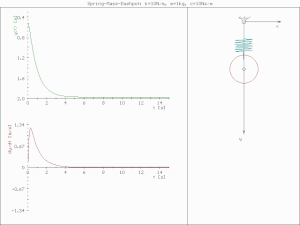
Spring mass overdamped
Forced vibration with damping
The behavior of the spring mass damper model varies with the addition of a harmonic force. A force of this type could, for example, be generated by a rotating imbalance.The amplitude of the vibration “X” is defined by the following formula.

The plot of these functions, called "the frequency response of the system", presents one of the most important features in forced vibration. In a lightly damped system when the forcing frequency nears the natural frequency () the amplitude of the vibration can get extremely high. This phenomenon is called resonance (subsequently the natural frequency of a system is often referred to as the resonant frequency). In rotor bearing systems any rotational speed that excites a resonant frequency is referred to as a critical speed.
If resonance occurs in a mechanical system it can be very harmful – leading to eventual failure of the system. Consequently, one of the major reasons for vibration analysis is to predict when this type of resonance may occur and then to determine what steps to take to prevent it from occurring. As the amplitude plot shows, adding damping can significantly reduce the magnitude of the vibration. Also, the magnitude can be reduced if the natural frequency can be shifted away from the forcing frequency by changing the stiffness or mass of the system. If the system cannot be changed, perhaps the forcing frequency can be shifted (for example, changing the speed of the machine generating the force).
The following are some other points in regards to the forced vibration shown in the frequency response plots.
- At a given frequency ratio, the amplitude of the vibration, X, is directly proportional to the amplitude of the force (e.g. if you double the force, the vibration doubles)
- With little or no damping, the vibration is in phase with the forcing frequency when the frequency ratio r < 1 and 180 degrees out of phase when the frequency ratio r > 1
- When r ≪ 1 the amplitude is just the deflection of the spring under the static force This deflection is called the static deflection Hence, when r ≪ 1 the effects of the damper and the mass are minimal.
- When r ≫ 1 the amplitude of the vibration is actually less than the static deflection In this region the force generated by the mass (F = ma) is dominating because the acceleration seen by the mass increases with the frequency. Since the deflection seen in the spring, X, is reduced in this region, the force transmitted by the spring (F = kx) to the base is reduced. Therefore, the mass–spring–damper system is isolating the harmonic force from the mounting base – referred to as vibration isolation. More damping actually reduces the effects of vibration isolation when r ≫ 1 because the damping force (F = cv) is also transmitted to the base.
- whatever the damping is, the vibration is 90 degrees out of phase with the forcing frequency when the frequency ratio r = 1, which is very helpful when it comes to determining the natural frequency of the system.
- whatever the damping is, when r ≫ 1, the vibration is 180 degrees out of phase with the forcing frequency
- whatever the damping is, when r ≪ 1, the vibration is in phase with the forcing frequency
Resonance causes
Resonance is simple to understand if the spring and mass are viewed as energy storage elements – with the mass storing kinetic energy and the spring storing potential energy. As discussed earlier, when the mass and spring have no external force acting on them they transfer energy back and forth at a rate equal to the natural frequency. In other words, to efficiently pump energy into both mass and spring requires that the energy source feed the energy in at a rate equal to the natural frequency. Applying a force to the mass and spring is similar to pushing a child on swing, a push is needed at the correct moment to make the swing get higher and higher. As in the case of the swing, the force applied need not be high to get large motions, but must just add energy to the system.The damper, instead of storing energy, dissipates energy. Since the damping force is proportional to the velocity, the more the motion, the more the damper dissipates the energy. Therefore, there is a point when the energy dissipated by the damper equals the energy added by the force. At this point, the system has reached its maximum amplitude and will continue to vibrate at this level as long as the force applied stays the same. If no damping exists, there is nothing to dissipate the energy and, theoretically, the motion will continue to grow into infinity.
Applying "complex" forces to the mass–spring–damper model
In a previous section only a simple harmonic force was applied to the model, but this can be extended considerably using two powerful mathematical tools. The first is the Fourier transform that takes a signal as a function of time (time domain) and breaks it down into its harmonic components as a function of frequency (frequency domain). For example, by applying a force to the mass–spring–damper model that repeats the following cycle – a force equal to 1 newton for 0.5 second and then no force for 0.5 second. This type of force has the shape of a 1 Hz square wave.
How
a 1 Hz square wave can be represented as a summation of sine
waves(harmonics) and the corresponding frequency spectrum. Click and go
to full resolution for an animation
In the case of our square wave force, the first component is actually a constant force of 0.5 newton and is represented by a value at 0 Hz in the frequency spectrum. The next component is a 1 Hz sine wave with an amplitude of 0.64. This is shown by the line at 1 Hz. The remaining components are at odd frequencies and it takes an infinite amount of sine waves to generate the perfect square wave. Hence, the Fourier transform allows you to interpret the force as a sum of sinusoidal forces being applied instead of a more "complex" force (e.g. a square wave).
In the previous section, the vibration solution was given for a single harmonic force, but the Fourier transform in general gives multiple harmonic forces. The second mathematical tool, "the principle of superposition", allows the summation of the solutions from multiple forces if the system is linear. In the case of the spring–mass–damper model, the system is linear if the spring force is proportional to the displacement and the damping is proportional to the velocity over the range of motion of interest. Hence, the solution to the problem with a square wave is summing the predicted vibration from each one of the harmonic forces found in the frequency spectrum of the square wave.
Frequency response model
The solution of a vibration problem can be viewed as an input/output relation – where the force is the input and the output is the vibration. Representing the force and vibration in the frequency domain (magnitude and phase) allows the following relation:
Frequency response model
The frequency response function (FRF) does not necessarily have to be calculated from the knowledge of the mass, damping, and stiffness of the system—but can be measured experimentally. For example, if a known force over a range of frequencies is applied, and if the associated vibrations are measured, the frequency response function can be calculated, thereby characterizing the system. This technique is used in the field of experimental modal analysis to determine the vibration characteristics of a structure.
Multiple degrees of freedom systems and mode shapes
The simple mass–spring–damper model is the foundation of vibration analysis, but what about more complex systems? The mass–spring–damper model described above is called a single degree of freedom (SDOF) model since the mass is assumed to only move up and down. In more complex systems, the system must be discretized into more masses that move in more than one direction, adding degrees of freedom. The major concepts of multiple degrees of freedom (MDOF) can be understood by looking at just a 2 degree of freedom model as shown in the figure.
2 degree of freedom model
The following analysis involves the case where there is no damping and no applied forces (i.e. free vibration). The solution of a viscously damped system is somewhat more complicated.[7]
The equation then becomes:
Eigenvalue problem
This is referred to an eigenvalue problem in mathematics and can be put in the standard format by pre-multiplying the equation byThe eigenvalues and eigenvectors are often written in the following matrix format and describe the modal model of the system:
- and
The eigenvalues for this problem given by an eigenvalue routine is:
The two mode shapes for the respective natural frequencies are given as:
Illustration of a multiple DOF problem
When there are many degrees of freedom, one method of visualizing the mode shapes is by animating them using structural analysis software such as Femap or ANSYS. An example of animating mode shapes is shown in the figure below for a cantilevered I-beam as demonstrated using modal analysis on ANSYS. In this case, the finite element method was used to generate an approximation of the mass and stiffness matrices by meshing the object of interest in order to solve a discrete eigenvalue problem. Note that, in this case, the finite element method provides an approximation of the meshed surface (for which there exists an infinite number of vibration modes and frequencies). Therefore, this relatively simple model that has over 100 degrees of freedom and hence as many natural frequencies and mode shapes, provides a good approximation for the first natural frequencies and modes†. Generally, only the first few modes are important for practical applications.| In this table the first and second (top and bottom respectively) horizontal bending (left), torsional (middle), and vertical bending (right) vibrational modes of an I-beam are visualized. There also exist other kinds of vibrational modes in which the beam gets compressed/stretched out in the height, width and length directions respectively. | ||
| The mode shapes of a cantilevered I-beam | ||
|---|---|---|
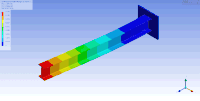 |
 |
 |
 |
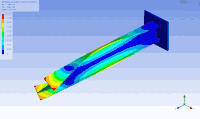 |
 |
Multiple DOF problem converted to a single DOF problem
The eigenvectors have very important properties called orthogonality properties. These properties can be used to greatly simplify the solution of multi-degree of freedom models. It can be shown that the eigenvectors have the following properties:These properties can be used to greatly simplify the solution of multi-degree of freedom models by making the following coordinate transformation.
Solving for x is replaced by solving for q, referred to as the modal coordinates or modal participation factors.
It may be clearer to understand if is written as:
















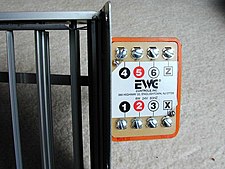











































































Comments